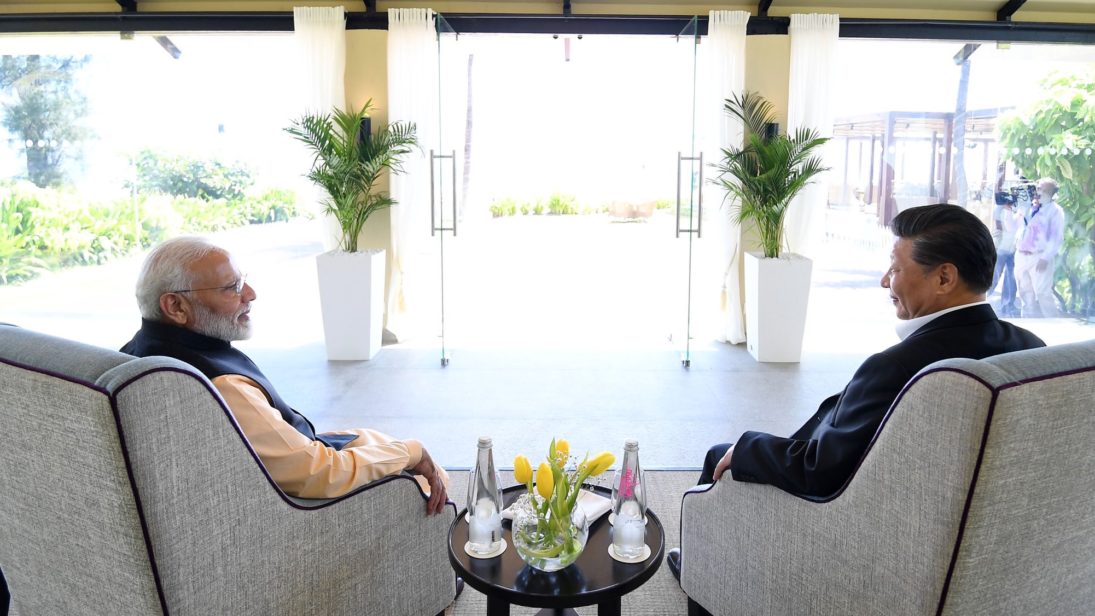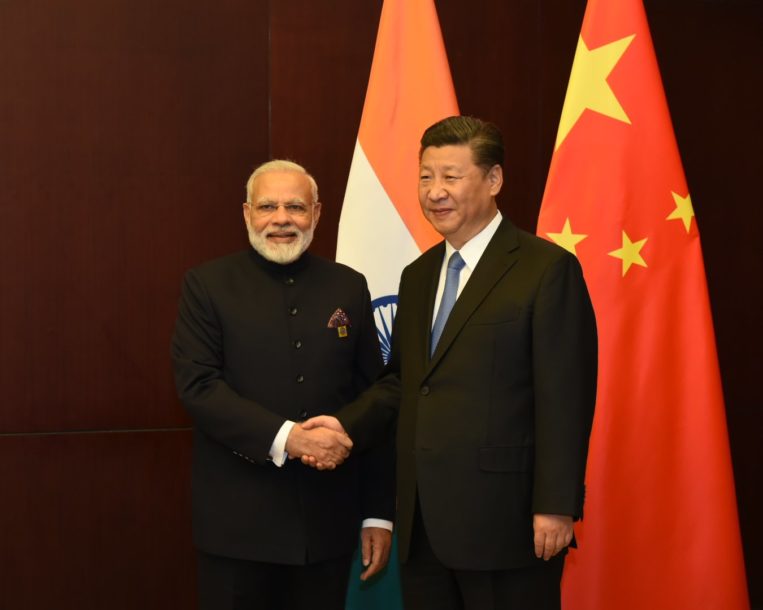
This year marks the 70th anniversary of Sino-Indian diplomatic relations. For most of this time, their ties have been bedeviled by territorial conflicts, status competition, and mutual distrust. Although in recent years both countries have introduced mechanisms to manage their rivalry, impasse over issues like the border dispute, resource sharing, and the Belt and Road Initiative (BRI) have deepened a mutual sense of hostility. Now, the outbreak of COVID-19 is bringing forth significant economic, geopolitical, and perceptual challenges to their already fragile bilateral ties. While the full ramifications of the pandemic remain unclear, in light of recent events, it seems likely that India-China ties would in the coming years be troubled by trade issues, regional power competition, and negative Indian perceptions of China.
Trade Relations
The pandemic is likely to shake the commercial peace underlying Sino-Indian relations. For one, their bilateral trade contracted by 12.4 percent in the first two months of the year, due to the coronavirus-related economic slowdown in both countries. This could potentially be compounded by the suspension of trade and business events planned to mark the 70th anniversary of the establishment of diplomatic ties, which would be a setback to efforts to promote investor confidence and facilitate engagement between the business groups of both countries. For New Delhi and Beijing, which have conventionally relied on economic integration and interdependence to constrain conflictual aspects of their bilateral ties, declining trade volume indicates falling economic exchange that in turn could reduce the incentive to cooperate and make ties vulnerable to disruption at lower levels of provocation. Additionally, measures to rejuvenate each nations’ respective economy in the wake of the pandemic may devolve into an economic zero-sum game between the two as they compete more aggressively for supply chains, export markets, and foreign investments.
For New Delhi and Beijing, which have conventionally relied on economic integration and interdependence to constrain conflictual aspects of their bilateral ties, declining trade volume indicates falling economic exchange that in turn could reduce the incentive to cooperate and make ties vulnerable to disruption at lower levels of provocation.
The first signs of discord are already evident. India’s decision to revise its Foreign Direct Investment policy to prevent against the opportunistic takeover of Indian companies due to COVID-19 has drawn a sharp reaction from Beijing, which has perceived the action as anti-China. Beijing has not yet responded to New Delhi’s plans to emerge as an alternative to China in the pharmaceutical drug market or court companies planning to shift production out of China. But as this economic competition intensifies, China might retaliate by refusing to address the current trade imbalance with India, hurting Indian exports and indirectly impacting the Indian job market. China might even consider strengthening Pakistan economically and militarily in order to counter India’s influence. Economic interests, which for long had been a mitigating factor in the Sino-Indian rivalry, could become a new source of tension going forward.
Regional Power Competition
With both China and India eager to play a leadership role in the pandemic, a simmering soft power competition between them is underway in South Asia through medical diplomacy. New Delhi has stepped up efforts to project a humanitarian image in the region by using the strength of its military power to aid its neighbors. In the early days of the crisis, the Indian Air Force provided essential overseas evacuation assistance to nationals of Bangladesh, Maldives, Sri Lanka, and Nepal, and as the crisis deepened, consignments of essential medical supplies and life-saving drugs were flown to these countries. Presently, six naval ships and five medical teams are on standby for emergency assistance to India’s neighbors. Further, in his bid to assert Indian leadership of the subcontinent, Prime Minister Narendra Modi called for regional collaboration to fight the pandemic and declared that India would contribute USD $10 million to a South Asian Association for Regional Cooperation (SAARC) emergency fund.
Similarly, Beijing has been promoting itself as a benign power in South Asia. In order to boost its diplomatic outreach, China convened a video conference with Eurasian and South Asian countries to share its experience of controlling the spread of the coronavirus and rushed essential medical supplies to Nepal, Bangladesh, and Sri Lanka, among others. Likewise, the Maldives, which has been at the center of Sino-Indian competition in recent years, received pandemic prevention aid from China just weeks after India sent a medical assistance team to the country to set up COVID-19 quarantine facilities. Beijing also offered Sri Lanka a USD $500 million loan. Finally, to limit India’s influence in the region, China has amplified its support for Pakistan by pledging to deepen strategic cooperation between the two countries and promote post-pandemic socioeconomic development through the China-Pakistan Economic Corridor. Although China’s image in the region has suffered due to the low quality of the medical supplies it has sent, Beijing is likely to use its financial power to rectify this reputational damage. In the long run, this evolving regional competition could exacerbate India’s fears of strategic encirclement by China and Bejing’s annoyance at India’s attempts to hegemonize South Asia. As a result, both countries could take to aggressive posturing, which could increase the possibility of a confrontation between them.

Negative Indian Perceptions of China
At the outset of the pandemic, the Indian government appeared reserved in condemning China for its role in the spread of the virus. However, later actions by the Indian government, such as an official from the Indian Council of Medical Research blaming Chinese equipment for setbacks in combating the coronavirus, have demonstrated its growing resentment towards China. Delays in receiving diagnostic kits from China due to export limits by Beijing, as well as the failure of Chinese protective equipment to meet Indian standards, has caused considerable exasperation within the Indian administration. Just recently, India canceled an order of a half a million Chinese test kits after they were found to be faulty. Additionally, the government decided to reduce reliance on China by expanding indigenous production of testing kits and protective equipment. These actions have become symbolic of the Indian government’s frustration with China’s perceived culpability in the outbreak of the pandemic and lack of integrity in helping its neighbors.
At the popular level, the outpouring of public anger towards China was evident from the start. A recent study by the Takshashila Institution found that 67 percent Indians blame China for turning COVID-19 into a global pandemic and that 52.8 percent of those polled did not find phrases like “Chinese virus” and “Wuhan virus” to be racist. These findings reflect a growing trend of xenophobic remarks against China and Chinese people by Indian citizens. This public resentment towards China has led hawkish voices within India to become more active, often advocating for a more aggressive approach towards China. The All India Bar Association has already filed a petition against China with the UN Human Rights Council, and in a recent essay, Brahma Chellaney, a prominent Indian strategic affairs expert, argued that India will never be able to forgive China for how it handled the COVID-19 outbreak.
A recent study by the Takshashila Institution found that 67 percent Indians blame China for turning COVID-19 into a global pandemic and that 52.8 percent of those polled did not find phrases like “Chinese virus” and “Wuhan virus” to be racist. These findings reflect a growing trend of xenophobic remarks against China and Chinese people by Indian citizens.
China’s reaction to these events has been mixed, suggesting a cautious approach in dealing with New Delhi. On the one hand, Beijing has officially protested against some of India’s measures, calling them “discriminatory,” “irresponsible,” and “unfair,” and the Chinese state media Global Times warned about the consequences of the stigmatization of China. But on the other hand, the state media has also published op-eds discussing the importance and benefits of India-China trade, with the Chinese ambassador to India, Sun Weidong, writing a column in the Hindustan Times reiterating the history of Sino-Indian cooperation.
This diplomatic squabbling and public anger indicates that the pandemic has reinforced India’s feelings of distrust of China. In the months ahead, as the economic and geopolitical competition between them intensifies, their negative perceptions of each other may exacerbate the hostility in their relationship.
Managing Sino-Indian Ties
Although these challenges are not new to the China-India relationship, they have been exacerbated by the pandemic. In order to prevent the escalation of these manageable differences into outright conflict, three measures can be considered.
First, both Beijing and New Delhi would have to give utmost importance to sustaining Sino-Indian economic and trade ties. Along with overseeing foreign investments, the Indian government would need to prevent bureaucratic red tape from obstructing trade between the two countries and work closely with the Chinese government in order to fast-track investments, especially those covering infrastructure and technology. For its part, China would have to be sensitive to India’s economic concerns and take measures that invoke confidence in Chinese trading practices, such as opening its markets to key Indian products and introducing more transparency in business agreements.
Second, as the possibility of inter-state tensions due to regional power competition arises, military-to-military communications could be strengthened to build mutual trust and understanding. The two countries could also adopt other measures such as exchanging information on the pandemic, undertaking technological collaborations, and strengthening cooperation through multilateral platforms such as the Shanghai Cooperation Organization, BRICS, and the Asian Infrastructure Investment Bank.
Third, to mitigate the impact of negative public perception on bilateral ties, India and China could plan cultural exchanges between their peoples to dispel such narratives. Track-II dialogues involving strategic affairs experts and academics from both countries could also be organized to identify new areas of cooperation.
Such measures would help build inter-state confidence and may mitigate the competitive aspects of the India-China relationship in a post pandemic world.
***
Image 1: Narendra Modi via Twitter
Image 2: Narendra Modi via Twitter


